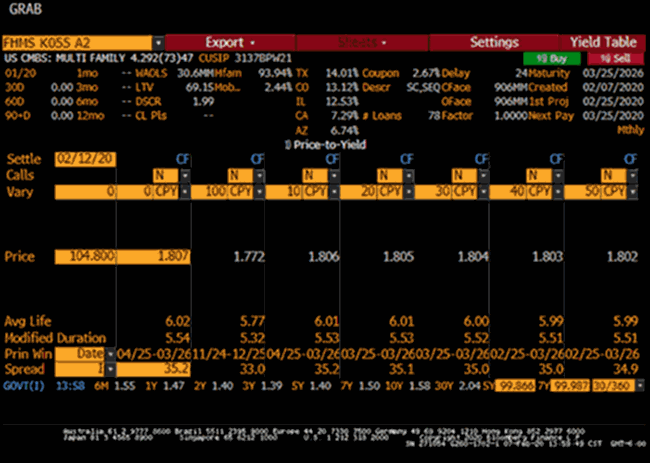Over the last several years, you may have invested in agency bullets (fixed rate, fixed term bonds) to create an investment ladder – investments maturing on a recurring schedule – to meet your credit union’s possible need for cash in the future. Bullets from the agencies, Fannie Mae (FNMA) and Freddie Mac (FHLMC), were widely available and offered more yield than Treasuries – securities issued by the Treasury Department. However, you may have noticed recently that bullets are harder to find, and sometimes their yield is barely above, or even below, the yield on Treasuries.
What can you do to keep your ladder structure intact?
Meet Freddie K. Freddie who? Although Freddie Mac has been offering Freddie K bonds for about 10 years, this may be the first time you’ve heard of them. Freddie K bonds are Multifamily K Certificates that are regularly issued, structured securities, backed by recently originated multifamily mortgage loans. The structure of the Freddie K Class A-2 bonds makes them an excellent alternative to agency bullets, and they can provide a higher yield. For example, a Freddie K A-2 bond was recently priced to yield 25 basis points more than an agency bullet with a similar term length.
How are Freddie Ks structured?
Freddie Mac underwrites, purchases and securitizes multifamily mortgage loans into a variety of products or “deals,” and the K-Deals are their signature multifamily mortgage-backed product. In general, K-Deal mortgages have terms of 5, 7, 10, and 12-15 years. They carry either a fixed or floating rate, a maximum loan-to-value ratio of 80 percent, and minimum debt service coverage ratios of 1.25x for fixed rates and 1x for floating rates. There are several classes of bonds within each K-Deal; our focus is on the A-2 class.
If they are mortgage-backed, how can Freddie Ks be an alternative to bullets?
Unlike other mortgage-backed securities, Freddie K A-2s do not amortize the principal each month. You still receive monthly interest payments, but the principal doesn’t come back to you until sometime during the last few – usually four – months of the bond’s term. This happens because borrowers can pay off their loan without penalty during the last three or four months of their loan’s term. This payment window at the end of the bond’s term may require a more flexible approach to your investment ladder’s structure.
 The yield table above shows the stability of the average life profile of the K-Deal investment. The first two columns show prepayment speeds of 0 CPY and 100 CPY. 0 CPY means there are no prepayments until the maturity date or balloon payment date, and 100 CPY means all loans prepay at the end of the prepayment penalty period. As you can see, the average life only increases from 5.77 years to 6.02 years with zero early prepayments. This is as close to a non-callable security as you can get when buying a mortgage-backed security structure.
The yield table above shows the stability of the average life profile of the K-Deal investment. The first two columns show prepayment speeds of 0 CPY and 100 CPY. 0 CPY means there are no prepayments until the maturity date or balloon payment date, and 100 CPY means all loans prepay at the end of the prepayment penalty period. As you can see, the average life only increases from 5.77 years to 6.02 years with zero early prepayments. This is as close to a non-callable security as you can get when buying a mortgage-backed security structure.
How can Freddie Mac pay a set interest payment over the bond’s life if mortgage principal is often paid off early?
Freddie Ks primarily use “defeasance” to ensure steady interest payments. A defeasance clause permits a borrower to release the property from the mortgage lien with the pledge of securities that are U.S. Treasuries or debt obligations issued by Freddie Mac, Fannie Mae, and/or Federal Home Loan Banks. The securities used must provide for payments that equal, or exceed, the scheduled interest and principal payments due under the related mortgage notes, including balloon payments at maturity.
What about borrower defaults?
Freddie Ks are structured to protect the bonds in which a credit union would want to invest, Class A-1 and A-2 bonds. Freddie Mac guarantees payment of interest and principal to Class A-1 and A-2 bond holders. They use subordinated classes (Classes B, C, and D) that are not guaranteed to be the first to absorb losses, should they occur. Losses to unguaranteed classes are rare. As of September 2019, $333.6 billion worth of Freddie Ks had been issued, and losses to investors in unguaranteed classes were less than one basis point of that total. Those minimal losses are the result of strict underwriting standards and post-securitization loan surveillance by servicers. Borrowers are current on 99.96 percent of the outstanding principal balance of Freddie Ks as of September 2019.
While it may be more difficult for credit unions to maintain an investment ladder as the agencies reduce their bullet offerings, Freddie Ks may be able to help. Freddie Ks feature a range of investor options with stable cash flows and a structured credit enhancement.
For more information on how Catalyst Corporate’s investment officers can assist you with Freddie K Class A-2 bonds, contact us today!
All securities are offered through CU Investment Solutions, LLC. The home office is located at 8500 W 110th St, Suite 650, Overland Park, KS 66210. CU Investment Solutions, LLC registered with the Securities and Exchange Commission (SEC) as a broker-dealer under the Securities Exchange Act of 1934. CU Investment Solutions, LLC is registered in the state of Kansas as an investment advisor. Member of FINRA and SIPC. All investments carry risk; please speak with your representative to gain a full understanding of said risks. Securities offered are not insured by the FDIC or NCUSIF and may lose value. All opinions, prices and yields are subject to change without notice.